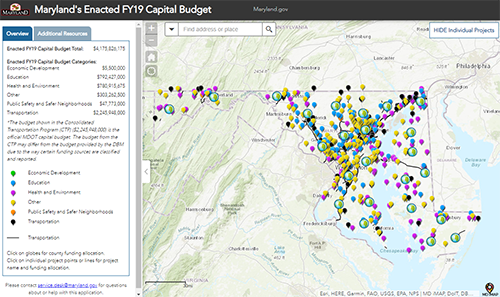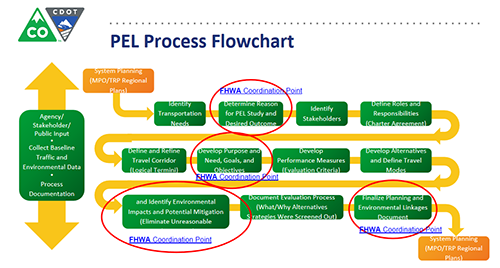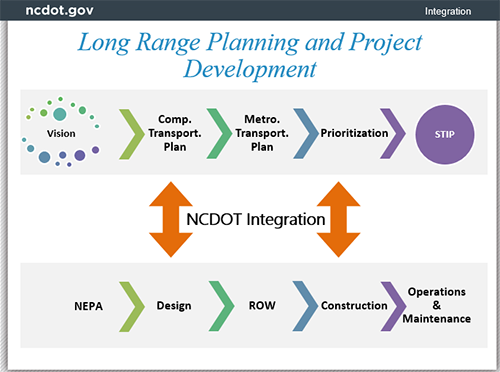Printer-friendly PDF →
Strategy: Planning and Environment Linkages Peer Exchange
Hanover, MD | December 12-13, 2017
This activity report summarizes the presentations and discussions. The summaries follow the order of appearance on the agenda. Each presentation summary is one page long, has a brief overview, findings, highlights from the participant discussion, and has a text box containing the speaker’s contact information. This peer exchange was funded through the Second Strategic Highway Research Program (SHRP2) product Expediting Project Delivery (C19).
Peer Exchange Notes
The peer exchange focused on discussing Planning and Environment Linkages (PEL) approaches and identifying recommendations and action items for Maryland’s State Highway Administration (SHA) to more formally implement PEL approaches in project development and delivery. Fifty-one participants from
MDOT
SHA, resource agencies, local agencies, and
FHWA
headquarters and division offices attended the peer exchange. Colorado DOT and North Carolina DOT served as the peers for this peer exchange and shared their experiences with PEL to guide MDOT SHA in thinking about how to implement PEL in Maryland.
Key Issues
Participants shared information on PEL approaches and identified how PEL approaches could be applied effectively in Maryland.
Products
Participants identified five key themes related to implementing PEL in Maryland. These five themes were then used to identify issues and opportunities for PEL in Maryland, which then led to the development of key action items.
Next Steps
Detailed action items were identified as a part of break out session #2, held on day two of the peer exchange. These action items are detailed in the break out session #2 summary at the end of this document. Each action item was assigned to a specific group or groups and was tied to an identified issue and opportunity.
For More Information
Contacts
Marisel Lopez-Cruz
Planning and Environment Linkages Program Co-Lead
FHWA Office of Project Development & Environmental Review
(407) 867-6402
Marisel.Lopez-Cruz@dot.gov
Resources
David Williams
Expediting Project Delivery Program Lead
FHWA Office of Project Development & Environmental Review
(202) 366-4074
David.Williams@dot.gov
Presentations referenced in this document are available upon request to Madison.Burke@dot.gov.
What is PEL?
Contact
Jody McCullough
Organization
FHWA Office of Environment
FHWA Office of Planning
Presentation Summary Provided an overview of what PEL is, how PEL can accelerate project delivery, background information on PEL, the benefits of PEL, and regulatory information on PEL approaches
Phone
(202) 366-5001
Email
Jody.McCullough@dot.gov
Presentation Highlights
- PEL uses the information, analysis, or products developed during planning to inform the environmental review process.
- PEL is authorized under multiple statutory authorities, the most recent authorities being:
- 23
USC
168 outlines conditions for adopting or incorporating by reference a planning product.
- 23 USC 139(f)(4) describes requirements for eliminating alternatives if studied in planning.
- Many conditions for PEL are already completed as part of the normal transportation planning process.
- FHWA provides many resources to support States using PEL, including a PEL Question and Answer and the PEL questionnaire.
Participant Discussion Highlights
Public Involvement
Under PEL, the lead agency or project sponsor is responsible for public involvement, as applicable. Transparency in the process is important.
PEL allows planning decisions, such as purpose and need and the elimination of unreasonable alternatives, to be made before beginning NEPA, if statutory conditions are met. PEL processes are not included in the NEPA time allotment. Planning funds become ineligible during NEPA.
MDOT SHA: Planning and Environmental Processes and Tools
Contact
Barry Kiedrowski
Organization
Maryland State Highway Administration
Presentation Summary Provided an overview of existing MDOT SHA environmental processes and prior PEL-like initiatives in Maryland. Presented on tools MDOT SHA currently uses in its planning processes.
Phone
(410) 545-8769
Email
BKiedrowski@sha.state.md.us
Presentation Highlights
- MDOT uses the Transportation Environmental Regulatory Process (TERP) to increase inter-agency coordination.
- MDOT uses the Model of Sustainability and Integrated Corridors (MOSAIC) tool to kick-start planning processes and quickly identify potential environmental issues.
- MDOT has completed three prior PEL-like efforts:
- A PEL study to identify potential transportation improvements for US 219 from I-68 to the Pennsylvania state line.
- A corridor planning study for MD 223.
- A feasibility study for US 50.
- MDOT uses iMap, a
GIS
tool, to make data publicly available and to expedite the initial planning process.

Source: MDOT SHA
CDOT PEL Study Framework & Resources
Contact
Sean Brewer
Organization
Colorado Department of Transportation
Presentation Summary CDOT leads a PEL program that focuses on larger-scale PEL studies. CDOT has completed 20 PEL studies since 2008. Through PEL, CDOT engages resource agencies and has found success with its Transportation Environmental Resource Council (TERC).
Phone
(303) 757-9978
Email
Sean.Brewer@state.co.us
Presentation Highlights
- CDOT’s PEL program focuses on fostering agency outreach, environmental scoping, and mitigation opportunities.
- The PEL process is flexible and can be used to make project or planning decisions.
- If a program or project is likely to have federal involvement in the future, PEL is a good tool to help streamline future NEPA processes.
- CDOT data from PEL studies can be used in NEPA if less than 5 years old.

Source: CDOT
Participant Discussion Highlights
PEL Benefits
CDOT has benefited from accelerated timelines and less required documentation on its PEL studies.
When to Use PEL
PEL is beneficial when projects would benefit from additional planning analysis prior to beginning NEPA.
Panel Discussion
Contact
Alena Cook
Organization
North Carolina Department of Transportation
Presentation Summary NCDOT uses a planning process called Integration, which links its long range planning and project development processes. Integration has improved efficiency and reduced redundancies in the planning process since being implemented in 2005.
Phone
(919) 707-0910
Email
ArCook@ncdot.gov
Presentation Highlights
- NCDOT uses a planning process called Integration to link its long range planning and project development processes.
- To increase inter-agency coordination, NCDOT implemented an Integration Implementation Team to provide a forum for long-range planners, NEPA practitioners, and other stakeholders to work together in the Integration process.
- NCDOT found that Integration improved efficiencies and reduced redundancies in the planning process.

Source: NCDOT
Participant Discussion Highlights
Organizational Structure
NCDOT uses a decentralized organizational structure where different divisions handle various requirements, but all divisions coordinate closely to ensure consistency.
Public Reaction
NCDOT has found that transparency and consistent language has been helpful to their Integration efforts with the public.
Break Out Session #1
Summary The break out included five tables organized around one of five key themes identified for the peer exchange. Each table came up with a list of issues and opportunities for their theme.
Discussion Highlights
Each theme of the discussion is listed below, with identified issues and opportunities listed below.
Statewide Data Management and Use
- Impacts and flexibility of PEL on agencies; comfort with pre-NEPA involvement
- Comfort level of resource agencies in using PEL data vs. NEPA data
- Appropriate level of data for PEL planning vs. NEPA? How often and in what way does pre-NEPA data need to be validated? How does the 5-year rule apply to PEL products?
- Harnessing existing and emerging tools and increasing knowledge of and access to tools, to facilitate PEL (MOSAIC, ArcGIS online, etc.)
Public Involvement and Communication
- Communicating difference from NEPA and managing expectations of local municipalities and elected officials concerning the benefits of a PEL approach
- Ensuring high-quality communication materials in lower-cost PEL studies
- Emphasizing use of modern communication channels like social media
- Clarify expectations for level of public involvement
- Articulating benefits (cost/time savings, other benefits) of PEL
- Selling points for public interest and regulatory/resource agencies’ participation in PEL
Stakeholder Involvement and Partnerships
- Comfort level of resource agencies in using PEL data vs. NEPA data
- Roles of
MPOs/RPOs
in contributing to PEL?
- What is the potential for planning organizations to play a role in expanding the PEL approach/PEL planning product development?
Planning and Environment Approach Timelines
- Risk of data shelf-life from planning/PEL activities remaining eligible for use in NEPA
- What other forms of input are appropriate to initiate a PEL study?
- Use state programming processes to identify statewide priorities through involvement of local governments
- Map planning/project development process; how to best use products from planning
PEL Products and Technical NEPA Issues
- Clarifying mechanisms in PEL that help ensure planning products are eligible for use in NEPA.
- Shelf life of PEL products
- Clarifying mechanisms for incorporating/adopting PEL planning products by reference
- Documentation to mitigate PEL product development risk of class of action
Break Out Session #2
Summary Participants identified issues, opportunities, responsible parties, and next step actions for each theme.
Discussion Highlights
For each identified theme, participants in this break out session identified the issue, opportunity, the responsible party, and next step actions to move forward with PEL in Maryland.
Statewide Data Management and Use
- Issue: Uneven data quality across national, state, regional and local owners, and within different overlapping datasets
- Opportunity: Use the PEL process to identify: 1) possible data, and 2) relevant data, and assess federal, state, regional, local unevenness
- Who: State-led group of data owners
- Actions:
- Develop a matrix of maximum data that is informative (to transportation projects and environmental resources)
- Define owners and level of analysis, data expiration date, data generation date.
- Design a process to mechanize (as much as possible) data collection, tracking, publishing, and updating
Public Involvement and Communication
- Issue: Do a better job of communicating about PEL (recognize PEL could be a new concept for public, even if PEL products are already known through existing planning or NEPA processes)
- Opportunity:
- Identify existing suite of public involvement and communication tools from NEPA outreach. Modify to increase ease of use and engagement of public; includes education of public about the PEL approach (in addition to project content)
- Step up interaction/collaboration with MPOs in engaging their constituents
- Develop an MDOT PEL communications plan
- Who:
- MDOT SHA project teams must understand and embrace PEL
- MDOT Office of Communications (top down media dissemination/social media)
- Project-based public outreach support teams
- IT support
- Senior Managers - bringing elected officials along in adoption of the PEL approach and its benefits
- Audiences include the general public; but all stakeholders as well
- Actions:
- Initial conversation with MPOs and State for cooperation
- Think through communications plan to guide efforts
- Coordinate internally for SHA - internal management and elected officials
- Explore suite of modern communication tools: visualization, social media
Stakeholder Involvement and Partnerships
- Issue: Varying capacity, sophistication, size, and context of MPOs and RPOs
- Opportunity: Strengthen and support MPOs’ capacity to lead the PEL approach
- Who:
- MPO’s host/lead if they are larger/more sophisticated
- State/SHA liaisons assist for smaller/less sophisticated MPOs/RPOs
- Actions:
- Develop a matrix of maximum data that is informative (to transportation projects and environmental resources)
- Define owners and level of analysis, data expiration date, data generation date
- Design a process to mechanize (as much as possible) data collection, tracking, publishing, and updating
Planning and Environment Approach Timelines
- Issue: When to use PEL (and when not to use PEL)?
- Opportunity: Clarify different types of studies/PEL approach to consistently identify when to use PEL and when NOT to
- Who:
- SHA Office of Planning
- Districts within Office of Traffic and Safety
- Transportation Business Units (units within MDOT)
- Actions:
- Categorize study types
- Interview internal stakeholders
- Create briefing to document findings including typical study types/outcomes (e.g. decision tree)
PEL Products and Technical NEPA Issues
- Issue: Lack of statewide understanding of what constitutes “PEL”
- Opportunity:
- Work with Modes/MPOs to define a “guidebook” defining PEL and the PEL approach
- Focus on multimodal projects
- Plan for guidebook updates to adapt/adopt new technologies into processes; and to incorporate changing priorities at the local, state, or federal levels
- Who: MDOT SHA Planning leading a team of modes/MPOs
- Actions:
- Identify funding
- Secure management buy-in
- Form guidebook management team
- Produce draft and final guidebook

